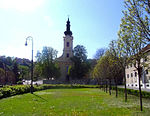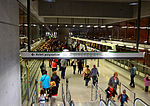Memento Park (Hungarian: Szoborpark) is an open-air museum in Budapest, Hungary, dedicated to monumental statues and sculpted plaques from Hungary's Communist period (1949–1989). There are statues of Lenin, Marx, and Engels, as well as several Hungarian Communist leaders. The park was designed by Hungarian architect Ákos Eleőd, who won the competition announced by the Budapest General Assembly (Fővárosi Közgyűlés) in 1991. On public transport diagrams and other documents the park is usually shown as Memorial Park.
A quote by the architect on the project: "This park is about dictatorship. And at the same time, because it can be talked about, described, built, this park is about democracy. After all, only democracy is able to give the opportunity to let us think freely about dictatorship."Memento Park is divided into two sections: Statue Park, officially named "A Sentence About Tyranny" Park after a poem of the same name by Gyula Illyés, and laid out as six oval sections; and Witness Square (also called "Neverwas Square"), which lies east of the main park entrance and is visible without payment. Statue Park houses 42 of the statues and monuments that were removed from Budapest after the fall of communism. Witness Square holds a replica of Stalin's Boots which became a symbol of the Hungarian Revolution of 1956, after the statue of Stalin was pulled down from its pedestal, and is flanked by two single storey timber structures housing the internal exhibition space, their design being evocative of simple internment camp buildings.












